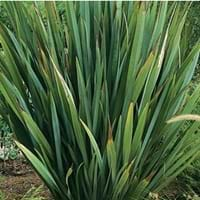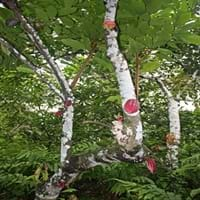Life Span
Perennial
Perennial
Origin
Hybrid origin
Mexico, Central America
Types
Phormium tenax,Phormium cookianum
Criollo, Forastero, Trinitario
Habitat
Cliffs, Mountain Slopes
Lowland, Tropical rainforest, Tropical regions
USDA Hardiness Zone
9-11
11-15
Sunset Zone
14, 15, 16, 17, 18, 19, 20, 21, 22, 23, 24
H1, H2
Habit
Clump-Forming
Oval or Rounded
Flower Color
Orange
White
Flower Color Modifier
Not Available
Bicolor
Fruit Color
Orange Red
Gold, Burgundy, Dark Red
Leaf Color in Spring
Yellow, Green, Pink
Light Green, Dark Green, Pink, Copper
Leaf Color in Summer
Yellow, Green, Pink
Light Green, Dark Green, Copper
Leaf Color in Fall
Yellow, Green, Pink
Light Green, Dark Green
Leaf Color in Winter
Light Green
Dark Green
Leaf Shape
Sword-like
Broad, Unlobed
Plant Season
Spring, Summer, Fall, Winter
Spring, Summer, Fall, Winter
Sunlight
Full Sun, Partial Sun
Partial Sun
Growth Rate
Medium
Medium
Type of Soil
Clay, Loam, Sand
Loam, Sand
The pH of Soil
Acidic, Neutral
Acidic, Neutral
Soil Drainage
Well drained
Well drained
Bloom Time
Summer
Indeterminate
Tolerances
Drought
Not Available
Where to Plant?
Container, Ground
Ground
How to Plant?
Seedlings
Seedlings, Stem Planting
Plant Maintenance
Medium
Medium
Watering Requirements
Needs more water during establishment
Keep ground moist, Requires watering in the growing season
In Summer
Lots of watering
Lots of watering
In Spring
Moderate
Moderate
In Winter
Average Water
Average Water
Soil pH
Acidic, Neutral
Acidic, Neutral
Soil Type
Clay, Loam, Sand
Loam, Sand
Soil Drainage Capacity
Well drained
Well drained
Sun Exposure
Full Sun, Partial Sun
Partial Sun
Pruning
Remove damaged leaves, Remove dead branches, Remove dead leaves
Prune to stimulate growth, Prune twice a year, Remove damaged leaves, Remove dead branches, Remove dead leaves
Fertilizers
All-Purpose Liquid Fertilizer
Ammonia sulphate, Nitrogen
Pests and Diseases
Red blotch
Borers, Insects, Phytophthora, Red blotch
Plant Tolerance
Drought
Shade areas, Wet Site
Flower Petal Number
Single
Single
Fragrant Leaf
Insignificant
No
Foliage Texture
Bold
Coarse
Foliage Sheen
Glossy
Glossy
Attracts
Hummingbirds
Not Available
Allergy
Anaesthesia
Diabetes, Diarrhea
Aesthetic Uses
Borders
Not Used For Aesthetic Purpose
Beauty Benefits
Not Available
Not Available
Environmental Uses
Air purification
Air purification
Medicinal Uses
anti-inflammatory, Antiseptic, Burns, Skin irritation
Anti-oxidant, Antioxidants, Asthma, Cancer, Cardiovascular problems, constipation, High cholestrol, Wounds
Part of Plant Used
Leaves, Sap
Leaves, Seeds
Other Uses
Container
Employed in herbal medicine, Used for its medicinal properties, Used in making beverages
Used As Indoor Plant
Yes
No
Used As Outdoor Plant
Yes
Yes
Garden Design
Bedding Plant, Container, Feature Plant, Foundation, Mixed Border
Edible, Feature Plant, Fruit / Fruit Tree, Shade Trees, Tropical
Botanical Name
PHORMIUM 'Apricot Queen'
THEOBROMA cacao
Common Name
New Zealand Flax
Cacao, Chocolate, Cocoa
In Hindi
New Zealand flax
कोको संयंत्र
In German
Neuseeländer Flachs
Kakaopflanze
In French
lin de Nouvelle-Zélande
usine de cacao
In Spanish
New Zealand flax
planta del cacao
In Greek
New Zealand flax
φυτό του κακάο
In Portuguese
espadana, linho-da-Nova-Zelândia
planta do cacau
In Polish
Nowa Zelandia lnu
Kakao roślin
In Latin
New Zealand flax
Cocos herba
Phylum
Magnoliophyta
Magnoliophyta
Class
Liliopsida
Magnoliopsida
Family
Agavaceae
Sterculiaceae
Clade
Angiosperms, Monocots
Angiosperms, Eudicots, Rosids
Subfamily
Hemerocallidoideae
Byttneroideae
Number of Species
Not Available
Season and Care of New Zealand Flax and Cocoa Plant
Season and care of New Zealand Flax and Cocoa Plant is important to know. While considering everything about New Zealand Flax and Cocoa Plant Care, growing season is an essential factor. New Zealand Flax season is Spring, Summer, Fall and Winter and Cocoa Plant season is Spring, Summer, Fall and Winter. The type of soil for New Zealand Flax is Clay, Loam, Sand and for Cocoa Plant is Loam, Sand while the PH of soil for New Zealand Flax is Acidic, Neutral and for Cocoa Plant is Acidic, Neutral.
New Zealand Flax and Cocoa Plant Physical Information
New Zealand Flax and Cocoa Plant physical information is very important for comparison. New Zealand Flax height is 121.00 cm and width 121.00 cm whereas Cocoa Plant height is 610.00 cm and width 370.00 cm. The color specification of New Zealand Flax and Cocoa Plant are as follows:
New Zealand Flax flower color: Orange
New Zealand Flax leaf color: Yellow, Green and Pink
Cocoa Plant flower color: White
- Cocoa Plant leaf color: Light Green, Dark Green, Pink and Copper
Care of New Zealand Flax and Cocoa Plant
Care of New Zealand Flax and Cocoa Plant include pruning, fertilizers, watering etc. New Zealand Flax pruning is done Remove damaged leaves, Remove dead branches and Remove dead leaves and Cocoa Plant pruning is done Prune to stimulate growth, Prune twice a year, Remove damaged leaves, Remove dead branches and Remove dead leaves. In summer New Zealand Flax needs Lots of watering and in winter, it needs Average Water. Whereas, in summer Cocoa Plant needs Lots of watering and in winter, it needs Average Water.





